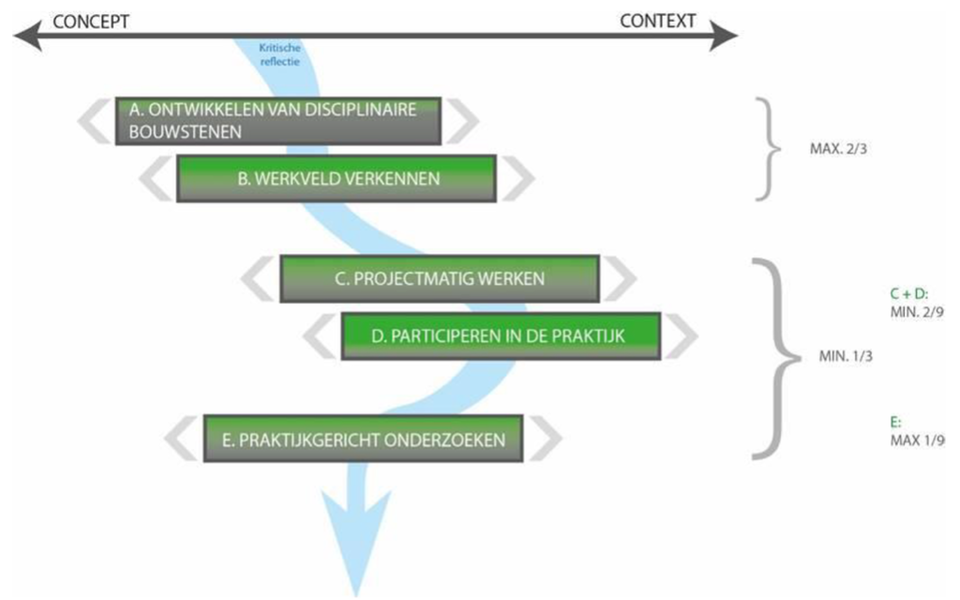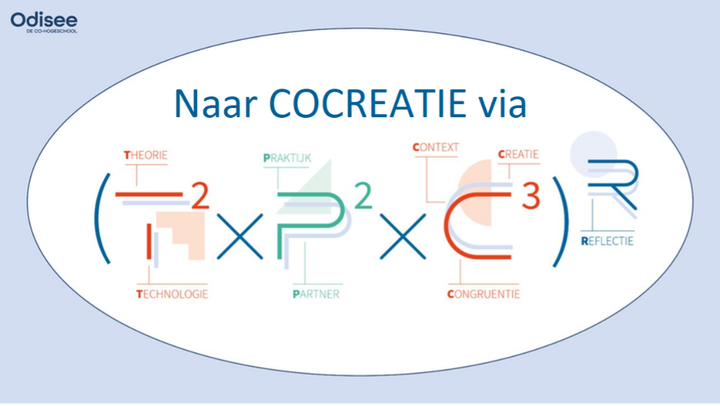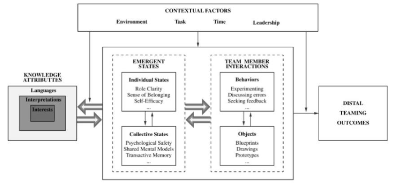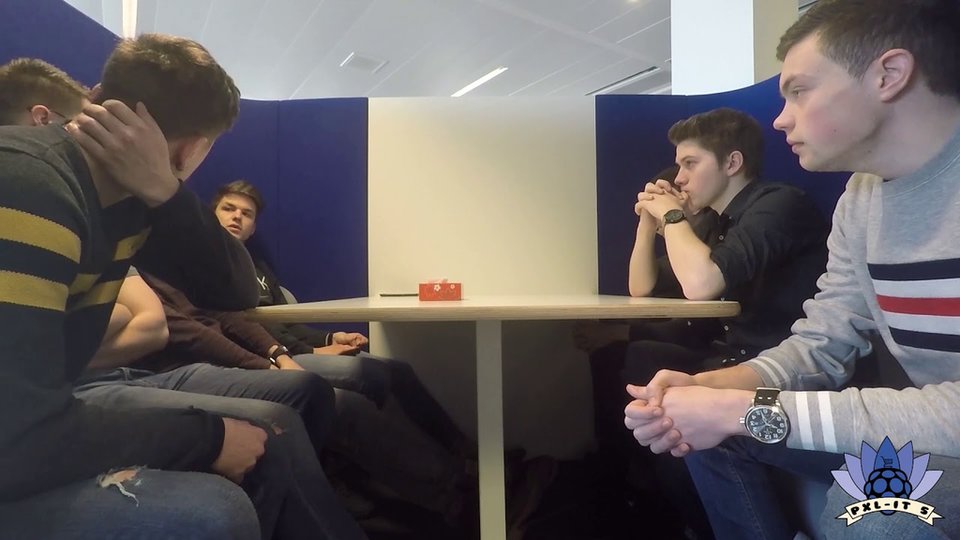COCREATIE WERKVELD
IN DE PRAKTIJK
THEMA 4
Studenten leren cocreëren
Om als professional te functioneren in een VUCA-wereld moeten studenten in staat zijn om nieuw gedrag te ontwikkelen dat een waardevol antwoord biedt op de uitdagingen van morgen. Door de snelle evoluties in het werkveld en in de maatschappij zullen onze afgestudeerden meer en meer met complexe, moeilijk te voorspellen problemen geconfronteerd worden. Daarom is het belangrijk dat we hun vermogen om oplossingsgericht te werken, om collectieve intelligentie in te zetten als antwoord op dergelijke problemen, gericht stimuleren.
Dat cocreëren en interdisciplinair kunnen werken belangrijke competenties zijn voor de toekomst zien we ook in de ESF-focusstudies naar toekomstige competentienoden in verschillende sectoren in Vlaanderen
(Van Hove & Desseyn, 2017): ‘De capaciteit om persoonlijke, specialistische kennis te verwerven, zal slechts gewaardeerd worden als men tegelijk ook de capaciteit heeft om die kennis uit te wisselen. Oplossingen zoekt men in de cocreatie’. Meer theoretische onderbouwing over de vaardigheden die het werkveld verwacht van studenten vind je in het artikel: Professional expertise, integrative thinking, wisdom, and phronesis (Tynjälä, Heikkinen, & Kallio, 2020).
De aandacht voor leren cocreëren om in staat te zijn te innoveren/complexe problemen op te lossen vinden we ook terug in het Model voor Authentiek Onderwijs van PXL Hogeschool en in de visie op cocreatie van Odisee.
Beide visies wijzen op het belang van authentieke contexten als bron van kansen om te leren cocreëren. Het is echter niet omdat studenten de gelegenheid krijgen om in een authentieke context te handelen, dat zij automatisch zullen (leren) cocreëren.
Enkele belangrijke aandachtspunten om studenten tot cocreatie te brengen:
Wees alert voor cocreatiekansen die zich voordoen in het werkveld.
Cocreatie vertrekt van een duidelijke urgentie die alle betrokkenen voelen. Laat aan je werkveldpartners blijken dat je ervoor openstaat om samen met je studenten aan de slag te gaan met uitdagingen waarvoor zij zich geplaatst zien, toon interesse hiervoor en zet zelf de stap om hen hierover te bevragen.
Wees je bewust van competenties en attitudes die belangrijk zijn voor cocreatie en bepaal waarin je je studenten wilt laten groeien. Voorbeelden van competenties zijn: integreren van ideeën, ondernemen, systeemdenken, creatief denken, interprofessioneel/internationaal samenwerken. Leg hierrond samen met het werkveld leerresultaten vast en/of beschrijf de attitudes die je wilt stimuleren. Nog sterker is het als er hierbij enige ruimte gelaten wordt voor variatie, en als docent, werkveld en student samen kunnen bekijken aan welke competenties gewerkt zal worden.
LEES MEER
Wees je bewust van competenties en attitudes die belangrijk zijn voor cocreatie en bepaal waarin je je studenten wilt laten groeien.
Voorbeelden van competenties zijn: integreren van ideeën, ondernemen, systeemdenken, creatief denken, interprofessioneel/internationaal samenwerken. Leg hierrond samen met het werkveld leerresultaten vast en/of beschrijf de attitudes die je wilt stimuleren. Nog sterker is het als er hierbij enige ruimte gelaten wordt voor variatie, en als docent, werkveld en student samen kunnen bekijken aan welke competenties gewerkt zal worden.
LEES MEER
Bouw geleidelijk aan de complexiteit op.
Cocreatie is een intensief en uitdagend proces. Studenten onvoorbereid in een situatie droppen waarin ze samen met een werkveldpartner een oplossing voor een complex probleem moeten cocreëren, zou eerder tot frustratie dan tot leerwinst leiden. Het is dan ook belangrijk om voldoende aandacht te hebben voor geleidelijkheid.
LEES MEER
Wees congruent en vraag dit ook van de werkveldpartners.
Bij meerdere cases zien we dat cocreatie een andere mindset vraagt van docenten: als je studenten wilt leren cocreëren, moet je ook bereid zijn zelf in een cocreatief zoekproces te stappen, waar je eerder de rol van medeparticipant dan van expert hebt. Belangrijk hierbij is ook de stappen die je in het cocreatief proces zet te expliciteren voor de studenten, zodat ze het waarom ervan inzien.
Ook van de werkveldpartners kan het een ‘mindswitch’ vergen om met studenten in een cocreatief zoekproces te stappen. Vaak vergt dit immers dat zij zich kwetsbaarder opstellen dan bij een doorsnee samenwerking het geval is. Het is aan te bevelen op voorhand bij de werkveldpartners te polsen of zij inzicht hebben in wat cocreatie is en of ze ondersteuning nodig hebben om te leren cocreëren.
LEES MEER
Hanteer passende vormen van evaluatie.
Een evaluatie die sterk de nadruk legt op scores sluit niet goed aan bij cocreatie, omdat dit de creativiteit kan afremmen. Bovendien is er nood aan diverse parallelle vormen van evaluatie om een goed beeld te krijgen van de deelname van een student aan een cocreatief proces, dat door veel factoren wordt beïnvloed.
In verschillende cases zien we daarom een combinatie van verschillende evaluatievormen aan bod komen, in functie van formatieve en summatieve evaluatie: zelfreflectie en zelfassessment, coachingsgesprekken die de studenten aanzetten tot reflectie, evaluatievormen waarbij intersubjectiviteit gehanteerd wordt zoals peerevaluatie en presentaties voor een jury. In vele gevallen wordt het werkveld ook bij de evaluatie betrokken. Tanja Vesala-Varttala adviseert om te experimenteren met leerdagboeken en portfolio’s.
LEES MEER
Zoek oplossingen voor praktische drempels.
Bij meerdere cases valt het op dat drempels zich vaak situeren op het praktische vlak.
SUGGESTIES OM HIERMEE OM TE GAAN
Hogeschool PXL
Community-driven education within the PXL Authentic Teaching Model
PXL University College has opted for an educational concept revolving around authenticity, innovation, and co-creation. In order to map out and further develop the Authentic Teaching approach within its programmes, the university college has developed the PXL Authentic Teaching Model. The community-driven educational model within the Information Technology cluster of programmes is a pre-eminent example of how the PXL Authentic Teaching Model is being substantiated. Within community-driven education, the daily practices of the business community and the research centres are integrated into the programme. The collective creation of education for and by the community of junior co-workers (students), co-workers, companies, and researchers is the linchpin within the operation of the cluster of programmes.
PXL University College has opted for an educational concept revolving around authenticity, innovation, and co-creation. To support the design process, it has developed its own PXL model in which several elements play a distinct role: authentic context, authentic learning tasks, professional processes, reflection, and articulation of the thought process. This means that every component of the programme must feature a certain degree of authenticity, taking account of the above elements.

Figure 1: PXL Authentic Teaching Model
The model comprises five core elements:
- The continuous coordination of conceptualisation and contextualisation (horizontal axis);
- On the one hand, the university college as a place of learning and on the other, the professional field as a place of learning and working (dark grey range vs green range);
- Critical reflection throughout all the authentic teaching and learning activities (blue line);
- Five clusters of authentic teaching and learning activities (clusters A, B, C, D, and E):
- Developing discipline-based building blocks;
- Exploring the professional field;
- Project-based working;
- Participating in actual practice;
- Practice-oriented research;
- Clusters C, D, and E account for at least one-third of the activities.
The community-driven educational model within the Information Technology cluster of programmes is a pre-eminent example of how the PXL Authentic Teaching Model is being substantiated. This model focuses on integrating the daily practices of the business community and the research centres. The collective creation of education for and by the community of junior co-workers (students), co-workers, companies, and researchers is the linchpin within the operation of the cluster of programmes.
The Applied Computer Science professional bachelor’s programme and the System and Network Management first degree programme of the Information Technology cluster have used the model to authenticate their curricula. Figure 2 provides insight into the division of authentic learning activities across the various components. The model affords the programmes the opportunity to render authentic teaching quantifiable, comparable, and open to discussion.

Figure 2: Overview of Authentic Teaching clusters implemented in the Information Technology cluster of programmes
Within the Applied Computer Science professional bachelor’s programme, the model is implemented via programme components (clusters A and B) and via authentic projects (clusters C, D, and E). Cluster A equips the students with specific building blocks (knowledge elements and basic skills) of the Information Technology discipline. Theory is given meaning by establishing links with reality through, e.g., Pluralsight courses, guest lecturers, and authentic assignments that tie in with the students’ social environment (developing MasterMind games, setting up a databank for a cinema et cetera). In cluster B, the students explore the professional field. In seminars, workshops, and innovation routes they observe IT professionals and/or workplace processes. They sample new/modern technologies (chatbots, clean code, test automation, social engineering et cetera) that are subsequently explored, analysed, and ultimately linked to theoretical concepts. Furthermore, with effect from the 2020-2021 academic year, the programme has embarked on designing and teaching a full programme component in collaboration with the professional field. Taking the attainment targets as their point of departure, business professionals develop authentic curriculum content of the eBusiness programme component in collaboration with lecturers and equip students with the essential building blocks in a co-teaching process. In the lessons, they continuously establish links with the actual professional practice.
The third-year IT Project programme component is situated within the clusters C, D, and E; it is a pre-eminent example of authentic teaching. Within the IT Project, junior co-workers collaborate in multi-disciplinary teams (cluster C) on a project basis, working on an authentic assignment for a client/principal in a realistic professional context (cluster D). The result is a final product/prototype providing an innovative solution to a complex, actual practical problem (cluster E). For example, students have developed an omni channel shop prototype, in co-creation with the Elision company, aimed at helping customers find the product they are looking for in a shop while reducing the boundary between their physical and digital experience:
PXL iSpace is creating a realistic professional context at Corda Campus, the IT site of the Dutch province of Limburg, the Euregio Dutch-German collaborative network, and the Belgian community of Flanders. iSpace spans more than 1000 m² and features such facilities as an open project hall, a classroom, and innovation labs. It offers students a place to experiment and collaborate in an authentic framework, 7/7 and 24/24. Furthermore, iSpace is being enhanced with additional project halls embedded within companies based at Corda Campus.
Within the System and Network Management first degree programme, the Authentic Teaching Model is being implemented via flanking programme components (clusters A and B) and work-based learning (clusters B, C, D, and E). It goes without saying that the programme has also embraced community-driven education. The learning process in work-based learning features a four-phase structure, as reflected in Figure 3.

Figure 3: Structure of work-based learning, System and Network Management first degree programme
In the Work-based Learning 1 phase, students are offered learning activities that enable them to get to know themselves and become acquainted with the professional field (cluster B, exploring the professional field). The emphasis is on becoming acquainted with the profession of system and network manager and on exploring technological evolutions within the domain. During guest lectures and company visits, hands-on experts explain their jobs and introduce students to present-day technologies. In addition, several workshops are organised to have students gain insight into their personal and professional identity and talents. In the Work-based Learning 2 phase, work-based learning is simulated via an authentic project (cluster C, project-based working). The project brief is formulated in consultation with the professional field. The professional field partners regularly provide interim feedback and assess the final product in collaboration with the learning coaches. The realistic professional context is once more created by iSpace at Corda Campus. The simulation projects ensure that students are sufficiently prepared before transferring to actual work situations in the Work-based Learning 3 and 4 phases (cluster D, participation in actual practice).
Added value
Students
Throughout the curriculum:
- Students are learning at and across the boundaries of school context and workplace. This expands their learning potential;
- Students are encouraged to adopt a project-based approach to finding solutions to practical problems;
- Students are practicing integrated professional skills, professional expertise, and professional mindsets in a realistic professional context;
- Students are learning to devise, field-test, and implement new methodologies and products that will result in the desired innovations;
Teaching staff
- Preserve a strong link with the professional practice;
The programme
- An up-to-date curriculum that ties in with the evolutions in the professional practice;
The professional field
- Influence on the study programme and the formation of excellent professionals;
- Graduates ready to start work immediately upon graduation;
- Opportunity to present themselves more distinctly to students (war for talent).
Challenges & opportunities
- Continued investment in the collective interests of co-creation;
- Coordinating and continuing to focus on the collective goal;
- Transparency in the collaboration in terms of expectations and responsibilities;
- Continued commitment to attracting good partners;
- Expanding collaboration with organisations/companies that are not active in the IT domain.
Contact
Professional Bachelor of Applied Computer Science
First Degree in System and Network Management
Corda Campus, Kempische Steenweg 293, Hasselt (Belgium)
PXL University College, Elfde-liniestraat 24, Hasselt (Belgium)
Tristan Fransen, Tristan.Fransen@pxl.be
Tine Aelter, Tine.Aelter@pxl.be
ODISEE HOGESCHOOL
Groeipad naar cocreatie
Wat verstaat Odisee onder cocreatie?
Cocreatie gebeurt door onderwijsprofessionals, studenten, onderzoekers, actoren uit werkveld en/of maatschappij.
is gericht op de oplossing van een complex probleem dat de individuele actoren niet alleen opgelost krijgen (geen cocreatie om de cocreatie). Alle actoren hebben invloed op het proces en het resultaat ervan, dragen bij en versterken elkaar vanuit eigen expertise, ervaring, talenten (gelijkwaardigheid, wederkerigheid).
Cocreatie staat in functie van een gezamenlijke ambitie en een gezamenlijk resultaat én in functie van win-win.
Er is veel aandacht voor een kwaliteitsvol proces en kwaliteitsvolle relaties. Dit is immers een noodzakelijke voorwaarde om diverse invalshoeken en expertises te combineren tot collectieve intelligentie i.f.v. een nieuwe, waardevolle oplossing. Het resultaat van de cocreatie is niet alleen dat er iets nieuws ontwikkeld is (product, dienst, beleid, …), maar ook dat de deelnemers geleerd hebben (nieuwe kennis/vaardigheden).
Cocreatie is geen vanzelfsprekend proces. Verschillende succesfactoren bepalen of cocreatie slaagt of niet. Een belangrijke factor is dat cocreatie vertrekt van een duidelijke urgentie die alle partners voelen. Verder zijn o.a. gedeelde doelen, vertrouwen en durf en daadkracht van belang (Ehlen, van der Klink, & Boshuizen, Co-Creatie-Wiel: instrument voor succesvolle innovatieprojecten, 2015).
Onze ambitie: een groeipad naar cocreatie
De kijk op leren (lerenden moeten ook in staat zijn om nieuw gedrag te ontwikkelen dat een antwoord biedt op de nieuwe uitdagingen van morgen; cocreatie is hierbij een hefboom) zit vervat in onze visie Odisee 2027 en in het Instellingsbreed Kader voor Curriculumopbouw, bijvoorbeeld via Odiseebrede leerresultaten als cocreëren, interprofessioneel samenwerken, ondernemen, … en via het principe de lerende aan zet. Meest expliciet klinkt het door in het vierde ontwerpprincipe: ‘het actief leren in authentieke en cocreatieve contexten’. De bijhorende rode krijtlijn die stelt dat alle opleidingen een groeipad naar cocreatie zoals hierboven omschreven in hun curriculum verweven, sluit daarbij aan. Zoals je niet kan leren zwemmen op het droge, kan je ook niet ten volle leren complexe professionele problemen oplossen op je eentje buiten authentieke werkcontexten.
Toch mogen we cocreatie en authentieke contexten als onderwijskundige concepten niet verabsoluteren. Studenten moeten wel degelijk tegen het einde van hun diplomatraject in staat zijn dergelijke complexe uitdagingen cocreatief aan te pakken, maar Odisee stelt niet dat haar onderwijs zich herleidt tot het confronteren van studenten met de ene na de andere complexe uitdaging in wisselende samenwerkingsverbanden. Wie van studenten verwacht dat ze te weinig voorbereid complexe professionele problemen in het werkveld aanpakken leidt hen niet op, maar voert hen naar frustratie. We verkiezen de veilige weg van de geleidelijkheid.
Daarom is het belangrijk dat cocreatie ingebed is in een ruimere visie op goed opleiden. De formule hieronder verbindt het concept cocreatie met het bredere opleidingsproces errond.

Elke student en toekomstige professional heeft een Theoretische kennisbasis nodig. Maar die is zowel in de breedte als in de diepte beperkt, want niemand kan alles weten over zijn vakgebied of alle vernieuwingen volgen. Belangrijk is dat studenten al tijdens hun opleiding leren omgaan met die beperkingen. Ze moeten ontbrekende informatie kunnen vinden en interdisciplinair samenwerken met mensen die hen aanvullen.
Een professional in de 21ste eeuw is die titel maar waardig als hij in staat is de juiste Technologie toe te passen in zijn beroepspraktijk. Zo wordt die praktijk kwalitatief beter en efficiënter.
Hogescholen zijn Praktijkgeoriënteerd, zowel in hun onderwijs en permanente vorming als in hun onderzoek. Maar die praktijk is voortdurend in verandering. Ook hier moeten studenten dus een evenwicht vinden tussen zich verdiepen in één bepaald segment en aanvoelen wat in andere praktijken gebeurt.
Dat alles kan alleen in nauwe samenwerking met Partners die hun knowhow willen vertalen naar state-of-the-artpraktijk. Die partners zijn overtuigd van de noodzaak en meerwaarde van cocreatie waarbij elke deelnemer bijdraagt vanuit eigen expertise, ervaring en talent.
Studenten moeten leren omgaan met verschillende Contexten. Want theorie, technologie en praktijk vloeien niet vanzelf samen. Ze moeten daarom proactief relaties aangaan, open communiceren met respect voor ieders eigenheid en ruimte krijgen om fouten te maken.
Creatie betekent: bijdragen tot iets nieuws, dat uitdagend en relevant is voor zowel de werkveldpartner als de student, lectoren en onderzoekers van de opleiding. Dat gaat verder dan kennis en vaardigheden toepassen in de stagepraktijk.
De hogeschool wil congruent opleiden, het goede voorbeeld geven en de keuzes die ze maakt vanuit die visie verduidelijken voor studenten en partners en ze staven met bronnen.
Reflectie ten slotte, zowel individueel als in groep, maakt het mogelijk om te leren over specifieke theorieën, technologieën, praktijken, partners, contexten en creaties heen. Alleen zo kunnen studenten duurzame, flexibele, onderzoekende en ondernemende professionals worden.
Een groeipad naar cocreatie betekent logischerwijs dat de waardes van elk van de factoren in het proces gedurig veranderen. Zo is er wellicht tijdens de eerste opleidingsfase in verhouding meer aandacht voor theorie en minder voor creatie. Maar een student die in de laatste opleidingsfase cocreëert met een werkveldpartner en een onderzoeker uit de opleiding zal wel nog gespecialiseerde kennis opzoeken om er een nieuwe passende toepassing aan te geven. De tweede belangrijke evolutie in het proces is dat naarmate de opleiding vordert meer en meer factoren in de definitie interageren. Zo zal een student reflecteren op reacties van verschillende partners op een creatieve oplossing die hij voorstelt voor een gedeeld probleem op de werkvloer. Studenten leren de samenhang tussen al die factoren zien en er proactief mee leren omgaan in een complexe realiteit, vergt ongetwijfeld ook een analoog groeiproces voor docenten en veel vertrouwen in elkaar.
INSPIRATIE
ONTDEK ONZE CASES
Model Edmonson en Harvey
Edmonson en Harvey (2018) bestudeerden grensoverschrijdende teams voor innovatie. Ze presenteren een model met een aantal factoren waarmee je rekening moet houden bij het werken in multidisciplinaire teams die gericht zijn op innovatie (Edmondson & Harvey, 2017).

#fab4+1 Odisee
Challenge Week Thomas More
Design for Impact LUCA School of Arts
Skill Tree-methodiek LUCA School of Arts
International Summer School Sustainable Management Odisee
Circle Sector LUCA School of Arts
PAUW Erasmushogeschool Brussel

